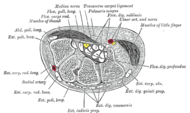
Phalen's maneuver
Encyclopedia

Carpal tunnel syndrome
Carpal Tunnel Syndrome is an entrapment idiopathic median neuropathy, causing paresthesia, pain, and other symptoms in the distribution of the median nerve due to its compression at the wrist in the carpal tunnel. The pathophysiology is not completely understood but can be considered compression...
discovered by an American orthopedist named George S. Phalen
George S. Phalen
George S. Phalen was an American hand surgeon remembered for his work on carpal tunnel syndrome including his description of Phalen's maneuver.- Biography :...
.
Process
The patient is asked to hold their wristWrist
In human anatomy, the wrist is variously defined as 1) the carpus or carpal bones, the complex of eight bones forming the proximal skeletal segment of the hand;...
in complete and forced flexion
Flexion
In anatomy, flexion is a position that is made possible by the joint angle decreasing. The skeletal and muscular systems work together to move the joint into a "flexed" position. For example the elbow is flexed when the hand is brought closer to the shoulder...
(pushing the dorsal surfaces of both hands together) for 30–60 seconds. The lumbricals attach in part to the flexor digitorum profundus tendons. As the wrist flexes, the flexor digitorum profundus contracts in a proximal direction, drawing the lumbricals along with it. In some individuals, the lumbricals can be "dragged" into the carpal tunnel with flexor digitorum profundus contraction. As such, Phalen's maneuver can moderately increase the pressure in the carpal tunnel via this mass effect, pinching the median nerve between the proximal edge of the transverse carpal ligament and the anterior border of the distal end of the radius
Radius (bone)
The radius is one of the two large bones of the forearm, the other being the ulna. It extends from the lateral side of the elbow to the thumb side of the wrist and runs parallel to the ulna, which exceeds it in length and size. It is a long bone, prism-shaped and slightly curved longitudinally...
. By compressing the median nerve
Median nerve
The median nerve is a nerve in humans and other animals. It is in the upper limb. It is one of the five main nerves originating from the brachial plexus....
within the carpal tunnel
Carpal tunnel
In the human body, the carpal tunnel or carpal canal is the passageway on the palmar side of the wrist that connects the forearm to the middle compartment of the deep plane of the palm. The tunnel consists of bones and connective tissue...
, characteristic symptoms (such as burning, tingling or numb sensation over the thumb, index, middle and ring fingers) conveys a positive test result and suggests carpal tunnel syndrome. Because not all individuals will draw the lumbricals into the carpal tunnel with this maneuver, this test cannot be perfectly sensitive or specific for carpal tunnel syndrome.
Accuracy
In studies of diagnostic accuracy, the sensitivitySensitivity
Stimulus|Sensitivity may refer to:* Sensitivity , the ability to react to a stimulus* Sensitivity , the strength of physical or emotional reaction in people* Sensitivity , variations in process dynamics and control systems...
of the Phalen's maneuver ranged from 51% to 91% and its specificity
Specificity
Specificity may refer to:* Being specific * Specificity , the proportion of negatives in a binary classification test which are correctly identified...
from 33% to 88%. Using the low end of the figures, this means it produces a positive result in over half people with carpal tunnel syndrome, but 2/3 of individuals without carpal tunnel syndrome will have a positive test also. Clearly if the lower end of the figures are both correct, the test is useless! But that seems unlikely as the test would have been abandoned long ago if more healthy people got a positive test than people with the disease. On the other hand, 91% sensitivity (91% of people with carpal tunnel syndrome get a positive test) and 88% specificity (only 12% of people *without* carpal tunnel have a positive test) would lead to a useful technique. Hopefully it will be possible to determine these figures more precisely with further research.
Reverse Phalen's test
This test is performed by having the patient maintain full wrist and finger extension for two minutes. The reverse Phalen's test significantly increases pressure in the carpal tunnel within 10 seconds of the change in wrist posture and the carpal tunnel pressure has the tendency to increase throughout the test's duration. In contrast, the change in carpal tunnel pressure noted in the standard Phalen's test is modest and plateaus after 20 to 30 seconds.The average pressure change for Phalen's test at one and two minutes was only 4 mm Hg. The average pressure changes in the carpal tunnel for the reverse Phalen's test were 34 mm Hg at one minute into the test and 42 mm Hg at the two minute point.
The extended wrist posture significantly changes the pressure within the carpal tunnel and may be more useful as a provocative examination maneuver. Reverse Phalen's maneuver results in a significantly higher intracarpal canal hydrostatic pressure as compared to a traditional Phalen's. This is thought to add to the sensitivity of conventional screening methods.

